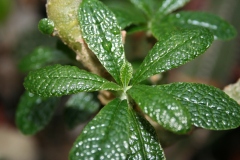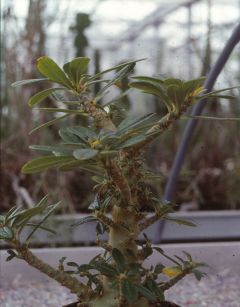Most people know of the tomato tree, but there is also a plant called the cucumber tree, which is endemic on the island of Socotra which belongs to Yemen, but lies closer to Somalia than to the Arabian Peninsula. It was discovered by Sir Isaac Bayley Balfour in 1882. It is extremely rare in cultivation with very few nurseries offering it for sale. It is a monotypic genus in the family of Cucurbitaceae and the only tree in the family, the rest being climbers. The temperature on the island is always more than 20°C, also at night, therefore this plant requires a high temperature in the greenhouse to grow. It can survive at lower temperatures, 15°C minimum, but it won’t grow well. It also prefers bright light, but will tolerate some shade. It can take a lot more water in the growing season, but be careful not to overwater it in the winter. If you keep the winter temperatures high enough (20°C or more), the plant will keep its green leaves, but will drop most of them them when kept cool (15°C). It can grow to a height of six metres, producing a whitish bark which contrast with the green leaves.
The flowers are produced after about five years from seed; the flowers are yellow as with most Cucurbitaceae and unisexual and monoecious (growing on the same plant). The fruit is orange, but fairly small and mainly eaten by the sheep and goats on the island. Traditionally, it is also used for medicine.
Propagation is mainly from seed, but a few exeperiments that I have done prove that it is possible to propagate the plant from cuttings. One needs tip-cuttings put it a high humidity propagation unit, so that the cuttings will not dry out. I do not yet know, however, if the plants will form a caudex if grown from cuttings. Experiments are ongoing.
For a more complete description of this interesting plant, see here.

Dendrosicyos socotrana






